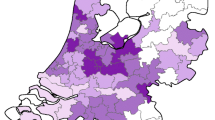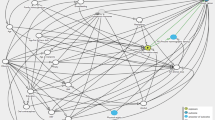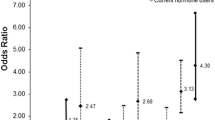Abstract
The objective of this pooled analysis was to compare differences in dense areas and percent mammographic densities to breast cancer incidence in populations at different breast cancer risk. The data set included 1,327 women aged 40–80: Caucasians from Norway, Arizona, and Hawaii, Japanese from Hawaii and Japan, Latina from Arizona, and Native Hawaiians from Hawaii. One reader performed computer-assisted quantitative density assessment for all mammographic films. Multiple linear regression models evaluated the influence of the covariates on breast density. Spearman correlation coefficients (r s) estimated the association between breast density and breast cancer incidence for the seven populations. After adjustment for covariates, ethnicity, but not location, was significantly associated with breast density. In the full model, 19% of the variation in the dense areas and 46% in the variation of percent densities were explained by measured risk factors. Native Hawaiians had the largest dense areas and women in Japan the smallest, whereas percent densities were highest among Native Hawaiians and Japanese in Hawaii and lowest among Norwegian women. The mean age-adjusted dense area had the strongest association with breast cancer incidence (r s = 0.93, P = 0.003); the relation with percent density was considerably weaker (r s = 0.32, P = 0.48). The correlation between age-adjusted dense area and breast cancer incidence remained strong after selectively removing individual data points. This comparison of mammographic densities suggests that, on a group level, age-adjusted dense areas may reflect breast cancer incidence better than percent densities.

Similar content being viewed by others
References
Miller BA, Kolonel LN, Bernstein L et al (1996) Racial/ethnic patterns of cancer in the United States 1988–1992. National Cancer Institute, NIH Pub. No. 96-4104, Bethesda, MD
American Cancer Society, Cancer Research Center of Hawaii, Hawaii Department of Health (2004) Hawaii cancer facts & figures 2003–2004. American Cancer Society
Pike MC, Kolonel LN, Henderson BE et al (2002) Breast cancer in a multiethnic cohort in Hawaii and Los Angeles: risk factor-adjusted incidence in Japanese equals and in Hawaiians exceeds that in whites. Cancer Epidemiol Biomarkers Prev 11:795–800
Ziegler RG, Hoover RN, Pike MC et al (1993) Migration Patterns and breast cancer risk in Asian-American women. J Natl Cancer Inst 85:1819–1827
MacMahon B, Cole P, Brown J (1973) Etiology of human breast cancer: a review. J Natl Cancer Inst 50:21–42
Henderson BE, Pike MC, Bernstein L, Ross RK (1996) Breast cancer. In: Schottenfeld D (ed) Cancer epidemiology and prevention. Oxford University Press, New York, pp 1022–1039
Boyd NF, Lockwood GA, Byng JW, Tritchler DL, Yaffe MJ (1998) Mammographic densities and breast cancer risk. Cancer Epidemiol Biomarkers Prev 7:1133–1144
Saftlas AF, Hoover RN, Brinton LA et al (1991) Mammographic densities and risk of breast cancer. Cancer 67:2833–2838
Boyd NF, Byng JW, Jong RA et al (1995) Quantitative classification of mammographic densities and breast cancer risk: results from the Canadian National Breast Screening Study. J Natl Cancer Inst 87:670–675
Byrne C, Schairer C, Wolfe J et al (1995) Mammographic features and breast cancer risk: effects with time, age, and menopause status. J Natl Cancer Inst 87:1622–1629
Maskarinec G, Meng L, Ursin G (2001) Ethnic differences in mammographic densities. Int J Epidemiol 30:959–965
Maskarinec G, Nagata C, Shimizu H, Kashiki Y (2002) Comparison of mammographic densities and their determinants in women from Japan and Hawaii. Int J Cancer 102:29–33
Chen Z, Wu AH, Gauderman WJ et al (2004) Does mammographic density reflect ethnic differences in breast cancer incidence rates? Am J Epidemiol 159:140–147
Boyd NF, Lockwood GA, Martin LJ, Byng JW, Yaffe MJ, Tritchler DL (2001) Mammographic density as a marker of susceptibility to breast cancer: a hypothesis. IARC Sci Publ 154:163–169
Boyd NF, Rommens JM, Vogt K et al (2005) Mammographic breast density as an intermediate phenotype for breast cancer. Lancet Oncol 6:798–808
Key TJ, Verkasalo PK, Banks E (2001) Epidemiology of breast cancer. Lancet Oncol 2:133–140
American College of Radiology (1993) Breast imaging reporting and data system (BI-RADS). American College of Radiology, Reston, VA
Maskarinec G, Lurie G, Williams AE, Le Marchand L (2004) An investigation of mammographic density and gene variants in healthy women. Int J Cancer 112:683
Maskarinec G, Pagano I, Lurie G, Wilkens LR, Kolonel LN (2005) Mammographic density and breast cancer risk: the multiethnic cohort. Am J Epidemiol 162:743–752
Kolonel LN, Henderson BE, Hankin JH et al (2000) A multiethnic cohort in Hawaii and Los Angeles: baseline characteristics. Am J Epidemiol 151:346–357
DeLellis K, Rinaldi S, Kaaks RJ, Kolonel LN, Henderson B, Le Marchand L (2004) Dietary and lifestyle correlates of plasma insulin-like growth factor-I (IGF-I) and IGF binding protein-3 (IGFBP-3): the multiethnic cohort. Cancer Epidemiol Biomarkers Prev 13:1444–1451
Maskarinec G, Williams AE, Stanczyk FZ, Franke AA (2002) A randomized isoflavone intervention among premenopausal women. Cancer Epidemiol Biomarkers Prev 11:195–201
Maskarinec G, Franke AA, Williams AE et al (2004) Effects of a 2-year randomized soy intervention on sex hormone levels in premenopausal women. Cancer Epidemiol Biomarkers Prev 13:1736–1744
Nagata C, Matsubara T, Fujita H et al (2005) Mammographic density and the risk of breast cancer in Japanese women. Br J Cancer 92:2102–2106
Gram IT, Bremnes Y, Ursin G, Maskarinec G, Bjurstam N, Lund E (2005) Percentage density, Wolfe’s and Tabar’s mammographic patterns: agreement and association with risk factors for breast cancer. Breast Cancer Res 7:R854–R861
Stram DO, Hankin JH, Wilkens LR, Henderson B, Kolonel LN (2000) Calibration of the dietary questionnaire for a multiethnic cohort in Hawaii and Los Angeles. Am J Epidemiol 151:358–370
Shimizu H, Ohwaki A, Kurisu Y et al (1999) Validity and reproducibility of a quantitative food frequency questionnaire for a cohort study in Japan. Jpn J Clin Oncol 29:38–44
Block G (1989) Health, habits, and history questionnaire – diet history and other risk factors, personal computer system packet. National Cancer Institute, Bethesda, MD
Thomson CA, Giuliano A, Rock CL et al (2003) Measuring dietary change in a diet intervention trial: comparing food frequency questionnaire and dietary recalls. Am J Epidemiol 157:754–762
Hjartaker A, Lund E (1998) Relationship between dietary habits, age, lifestyle, and socio-economic status among adult Norwegian women. The Norwegian women and cancer study. Eur J Clin Nutr 52:565–572
Byng JW, Boyd NF, Little L et al (1996) Symmetry of projection in the quantitative analysis of mammographic images. Eur J Cancer Prev 5:319–327
Byng JW, Boyd NF, Fishell E, Jong RA, Yaffe MJ (1994) The quantitative analysis of mammographic densities. Phys Med Biol 39:1629–1638
SAS Institute Inc. (2004) SAS OnlineDoc 9.1.2. SAS Institute Inc., Cary, NC
Armitage P (1971) Statistical methods in medical research. Blackwell Scientific Publications, Oxford
Vachon CM, Kuni CC, Anderson K, Anderson VE, Sellers TA (2000) Association of mammographically defined percent breast density with epidemiologic risk factors for breast cancer (United States). Cancer Causes Control 11:653–662
El Bastawissi AY, White E, Mandelson MT, Taplin SH (2000) Reproductive and hormonal factors associated with mammographic breast density by age (United States). Cancer Causes Control 11:955–963
Boyd NF, Lockwood GA, Byng JW, Little LE, Yaffe MJ, Tritchler DL (1998) The relationship of anthropometric measures to radiological features of the breast in premenopausal women. Br J Cancer 78:1233–1238
Braaten T, Weiderpass E, Kumle M, Adami HO, Lund E (2004) Education and risk of breast cancer in the Norwegian-Swedish women’s lifestyle and health cohort study. Int J Cancer 110:579–583
Haars G, Van Noord PA, van Gils CH, Grobbee DE, Peeters PH (2005) Measurements of breast density: no ratio for a ratio. Cancer Epidemiol Biomarkers Prev 14:2634–2640
Maskarinec G, Meng L (2000) A case-control study of mammographic densities in Hawaii. Breast Cancer Res Treat 63:153–161
Ursin G, Ma H, Wu AH et al (2003) Mammographic density and breast cancer in three ethnic groups. Cancer Epidemiol Biomarkers Prev 12:332–338
Harvey JA (2004) Quantitative assessment of percent breast density: analog versus digital acquisition. Technol Cancer Res Treat 3:611–616
Skaane P, Balleyguier C, Diekmann F et al (2005) Breast lesion detection and classification: comparison of screen-film mammography and full-field digital mammography with soft-copy reading – observer performance study. Radiology 237:37–44
Boyd N, Martin L, Stone J, Little L, Minkin S, Yaffe M (2002) A longitudinal study of the effects of menopause on mammographic features. Cancer Epidemiol Biomarkers Prev 11:1048–1053
Hawaii Department of Health (2004) 2003 State of Hawaii Behavioral Risk Factor Surveillance System. Hawaii Department of Health, Honolulu, HI; http://www.hawaii.gov/health/statistics/brfss/brfss2003/state03.html. Accessed on 1-12-2005
Shimizu H (1996) A basic report on Takayama study. Department of Public Health, University School of Medicine, Gifu, Japan
Boyd NF, Dite GS, Stone J et al (2002) Heritability of mammographic density, a risk factor for breast cancer. N Engl J Med 347:886–894
Pike MC, Krailo MD, Henderson BE, Casagrande JT, Hoel DG (1983) ‘Hormonal’ risk factors, ‘breast tissue age’ and the age-incidence of breast cancer. Nature 303:767–770
Acknowledgements
This combined project was funded by Grant R03 CA105948 from the National Cancer Institute. The studies in Hawaii were supported by NIH Grants R01 CA80843 and R01 CA 85265 and by an award from the U.S. Army Medical Research Materiel Command under DAMD17-00-1-0281. The data collection in Japan was funded by NIH Grant R03 CA 81620 and by a grant from the Ministry of Education, Science, Sports, and Culture, Japan. The Arizona Study was supported by the Susan G. Koman Breast Cancer Foundation. BCTR 2000 538. The Norwegian part of the study was supported by the Department of Clinical Research; University Hospital of North Norway, the Norwegian Cancer Society, the Aakre Foundation, the Norwegian Women’s Public Health Association (Grant H3-02), the Research Council of Norway (Visiting Scientist Award grant 148365/300), and the University of Tromsø, Norway. We are grateful to Laurence N. Kolonel and Brian E. Henderson for access to the Multiethnic Cohort study, Eiliv Lund for the collaboration with the NOWAC study and the use of the diet questionnaire, Ilene Brill for her programming efforts, and Lynne Wilkens for her statistical advice. Last and most importantly, we want to thank the women participating in the studies.
Author information
Authors and Affiliations
Corresponding author
Rights and permissions
About this article
Cite this article
Maskarinec, G., Pagano, I., Chen, Z. et al. Ethnic and geographic differences in mammographic density and their association with breast cancer incidence. Breast Cancer Res Treat 104, 47–56 (2007). https://doi.org/10.1007/s10549-006-9387-5
Received:
Accepted:
Published:
Issue Date:
DOI: https://doi.org/10.1007/s10549-006-9387-5




